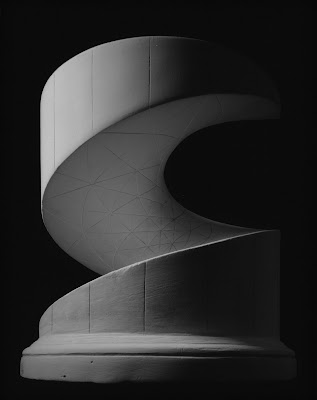
Trying to summarise Hiroshi Sugimoto's work up in a blog posting is an impossible task - I'll leave you to read the rather large retrospective book of the same name. All I want to do here is pick and chose a few of my favourites from his work.
Sugimoto has worked on a number of what may initially seem unconnected projects. But in a way they all do have an underlying theme - which is time - or more accurately, the passing of time and different kinds of time. The work has ranged from wax portrait and museum work, to the movie theatres, seascapes and architecture, on to mathematical forms and now fossils, among other things (he comments that fossils are really just photographs that take a long time to develop...
Of his work to date, my favourites would have to be the movie theatres, the seascapes and the architecture - followed by the mathematical forms (though having worked on and off in museums, I also have a fondness for the dioramas).
Sugimoto has worked on a number of what may initially seem unconnected projects. But in a way they all do have an underlying theme - which is time - or more accurately, the passing of time and different kinds of time. The work has ranged from wax portrait and museum work, to the movie theatres, seascapes and architecture, on to mathematical forms and now fossils, among other things (he comments that fossils are really just photographs that take a long time to develop...
"Fossils work almost the same way as photography...as a record of history. The accumulation of time and history becomes a negative of the image. And this negative comes off, and the fossil is the positive side. This is the same as the action of photography. So that’s why I am very curious about the artistic stage of imprinting the memories of the time record. A fossil is made overOne thing about Sugimoto's work is it's often close to unique - he finds a very different way of approaching something, works with it and then moves on. He doesn't try and repeat himself, or milk an idea until it's long past dead. But equally, while he manages to find a unique approach, he manages to do so with turning it into a novelty. Those are two dangers plenty of others don't actually manage to avoid
four-hundred-fifty million years—it takes that much time. But photography, it’s instant. So, to me, photography functions as a fossilization of time.")
Of his work to date, my favourites would have to be the movie theatres, the seascapes and the architecture - followed by the mathematical forms (though having worked on and off in museums, I also have a fondness for the dioramas).

I once went to see a movie in San Francisco (Evita of all things) in a most beautiful ornate old theatre - but which had a strange sense of familiarity to it. It was only later that I realised it was one which Sugimoto had photographed. As I understand it, he made his photographs by using an extremely long exposure and photographing for the whole length of the movie - which lit the theatre but left a blanked out white screen. He also felt that the nature of the movie led to different results in the way the final photograph looked.
The seascapes are minimal and yet never really repetitive. In fact looking at a sequence of them - from different areas of the world - it's very easy to get drawn right into them. I think some where taken with very short exposures, while others were taken over several hours.

I should add, these are definitely the sort of works which do really benefit from being printed quite large - they need the space.
With Sugimoto, I'm always waiting to see what he is going to do next, while I don't tire of going back over his work.
 The Hirshorn has a very nice web presentation of their recent exhibit of his work
The Hirshorn has a very nice web presentation of their recent exhibit of his workThere is also an interview on PBS (links at the bottom of the page) - it also includes a fascinating slideshow of him planning an exhibition.
(For the technically minded, I seem to recall that he still works mainly in 8x10, with Tri-X in D23 to keep the contrast under control. And he likes to photograph @f64 - joking that he's the last of the Group F64)







1 comment:
The cinema theathers and the seascapes are
fantastic in the 16x20" size I have seen them printed in. I have yet to digest the architecturals.
But I find the portraits at Madame Tussauds plain
boring.
Post a Comment